
Booze, Sailors & Health Menu: 1 2 3 4 5 6 7 8 9 10 11 12 13 14 15 16 17 18 19 Next>>
Booze, Sailors, Pirates and Health In the Golden Age of Piracy, Page 2
Containers for Alcohol: Bottles
If there is a container which stands in the middle of the field between containers used for shipping and those used for drinking, it is the regular round bottle. It was used to store as well as transport beverages from the cask to the glass. Historian Olive R. Jones comments, "One of the most successful containers produced by English glass factories has been the dark green glass 'wine' bottle."1 They are found in a variety of the sailor's and pirates' accounts from the golden age of piracy.
1 Olive R. Jones, Cylindrical English Wine and Beer Bottles 1735-1850, 1986, p. 11
Containers for Alcohol: Bottle History
While regular glass bottles existed before the mid-17th century, they were so fragile that they were poorly suited for shipping. These glass
,_anonymous_painter_17thc.jpg)
Sir Kenelm Digby (17th c,)
bottles "were usually small (two to three inches in height), often square or hexagonal, thin-blown, and made of green glass with mould-blown ribbing or wrythen [twisted] designs, or occasionally of cristallo [a form of clear glass]."1 The transition from these small and delicate bottles to the more industrial dark green or black 'onion' bottles began in
the early 1630s with polymath Sir Kenelm Digby. Digby was a former privateer who turned his attention to inventing after the death of his wife. With the help of James Howell, Digby was able to devise a way to make stronger bottles. "Together they worked out that tunnels going into the glass furnace would increase the heat ...and, the higher the temperature, the stronger the glass. This worked by drawing oxygen into the fire making it burn more fiercely"2.
Digby and Howell produced "a thick, strong, dark bottle"3 which was much better suited for storage and travelling. Although Digby was not around to see it, these bottles began to be produced in large quantities by the 1650s. The new bottles improved upon the older glass bottles and usurped stone bottles creating an "expanding market in bottles of larger and standard capacities - gallons, pottles, quarts, pints, and half-pints"4. Historian Olive R. Jones notes that "By the end of the 17th century the bottle-glass market had become so large that there were about 42 glasshouses producing bottles in England with an annual output of 240 000 dozen, nearly three million single bottles."5
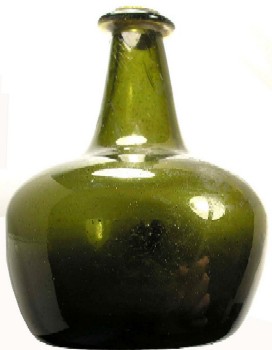
Photo: Kate Sumnall
The Traditional Dark Green Onion Bottle (1670-1700)
Most of these had a dark olive green or brown cast which was a result of the iron oxide found in the sand used to make them. "An amount as small as one-tenth of one per cent renders the glass decidedly green... and amounts up to three or four per cent, which are not uncommon, produce a dark green glass which cannot be disguised except by rendering the glass dark brown or black."6 Iron oxide produced brown shades when certain conditions occurred during the melting of the ingredients.7 Black was the only color not caused by the iron oxide; it was a result of the switch from wood to coal, which was necessary to more effectively melt the glass ingredients. "The dark colour resulting from contamination from the coal fumes was not considered
to be a disadvantage" and was even copied by French bottle-makers.8
This new, more durable type of glass also resulted in a dramatic change in the style of bottles produced. "Instead of being thin-blown, light in weight, pale in colour, and frequently square at the base, the[se] are heavy, strong, and globular in shape with a high 'kick' in the bottom and a long tapering neck ending in a collar for tying down corks. The colour was always very dark, varying from dark olive to brown or black."9 George Ravenscroft helped make the wine bottle even stronger and more stable by adding lead oxide their manufacture in 167510. While Digby's bottles were tall, with a relatively modest globular base, over time there was the bottle got shorter and the size of the globe bulged until near the end of the golden age of piracy when it began to grow a little taller again (see the image below).
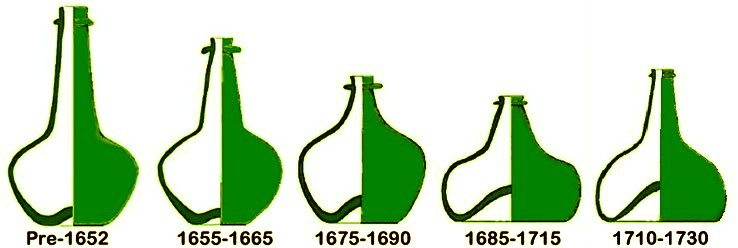 'Onion' Bottle Styles From Digby to 1730, Based On Images Found in R.J Charleston's English Glass, 1984, p. 96-7 |
Once bottles began to be used for storage and shipping, it was discovered that some alcohols aged better in them as opposed to those put into casks. "Certain products, primarily wine, fortified wines, and cider can be improved in the bottle. Even as early as the 1630s the East India Company had noticed that cider should be matured for a year before it was drunk"10.
1 Eleanor S. Godfrey, The Development of English Glassmaking 1560-1640, 1975, p. 226; 2 Henry Jeffreys, Empire of Booze, 2016, p. 16; 3 Godfrey, p. 228; 4,5 Olive R. Jones, Cylindrical English Wine and Beer Bottles 1735-1850, 1986, p. 11; 6 Godfrey, p. 157; 7 Godfrey, p. 3; 68 Godfrey, p. 150; 9 Godfrey, p. 229; 10 Jones, p. 21; 10 Tim Unwin, Wine and the Vine, 2005, p. 228
Containers for Alcohol: Bottle Use
Bottles were sometimes used to ship alcohol commercially. Archeologist and historian Olive R. Jones reports, "By the late 17th century bottled beers, wines, and other liquors were being shipped as far as India. For example, the Rising Sun sailed from Greenwich to India in 1703-4 carrying more than 5000 bottles of liquor,
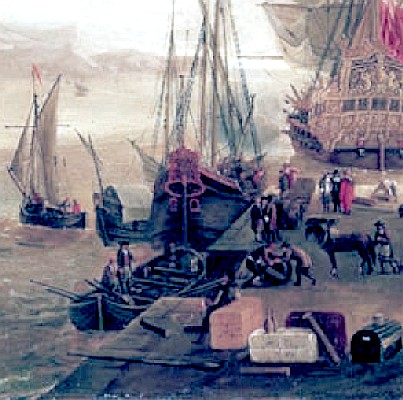
Artist: Jacob Knyff
Stores Waiting to Be Loaded on Ships, Including Green Bottles (1673)
including 2500 bottles of beer. The bottles were packed in chests complete with locks and hinges"1. Unfortunately, she does not mention whether these were case bottles or regular round bottles. Jones goes on to explain that even though "casks were used for the bulk of the overseas trade, bottled English and Scottish porters and ales, Hereford cider, and assorted wines appeared regularly in North American newspaper advertisements."2 These would likely have been round bottles. So there was some amount of trade being carried out with bottled alcohol during this period.
Bottles were also a featured container in the ship's officer's mess as well as for treating other captains and shore-based businessmen and traders. When mutineers Phineas Bunce and Dennis Mccarty were hatching their plot to take over several vessels in the Bahamas, they began by asking "to be treated with a Bottle of Beer, for they knew Mr. Carr [the supercargo of the voyage] had some that was very good in his Care, which had been put on board, in order to make Presents of, and to treat the Spanish Merchants with."3 Once Bunce and Mccarty and their cohorts had taken the three vessels in the small fleet, the mutineers notes that they "went on Shore, carrying with them six Bottles of Wine and some Biscuits. …they drank all the Wine themselves to the last Bottle"4 and later sent "two Bottles of Wine, a Bottle of Rum, and some Biscuits" to the former ship's officers, marooned on land.5 The narrative doesn't specifically say that they got these bottles by raiding the supercargo's supply, although, given the limited quantities mentioned, it seems likely.
Edward Barlow mentions that while serving aboard the Reall Ffriendship merchant vessel in 1677 that they had "some bottles of wine... [in] a hamper which was sent as a token to a merchant"7.
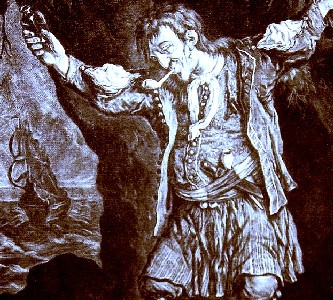
Artist: Jacob Gole
Dutch Sailor with Case Bottle Celbrating in Port (1695)
While rummaging around the captured merchant pink Mary Anne, pirate Samuel Bellamy's men "found it difficult to Come to the Wines in the hold, and so returned to their own Ship without any wine, Except five bottles of green wine which the found in the pinks Cabbin and carryed away"6. This likely came from the ship's officer's stash.
In addition, bottles were a way for individuals to transport small amounts of alcohol for personal use on a ship. In his account of a group of captured sailors planning to escape from pirate John Phillips' crew, John Fillmore recounts how one nervous man nearly gave away the plot when Phillips noticed how pale he was. Fillmore reports, "I cloaked the matter by informing him [Phillips], that Harridon had been sick all night, and I believed a dram would help him. Phillips told me to go to his case and get a bottle of brandy; which I did, and we all drank heartily"8.
Edward Barlow explains that part of the 'crossing the line' ceremony performed in his 1670 for men who had not previously crossed the equator involved each uninitiated man "paying his bottle of strong waters as a forfeit, it being merrily drunk out by all the rest that had been there before"9 . The practise was still going strong eleven years later when Barlow reported "we crossed the North Tropic [Tropic of Cancer], making all that had not been there before to pay their bottles of wine or brandy"10.
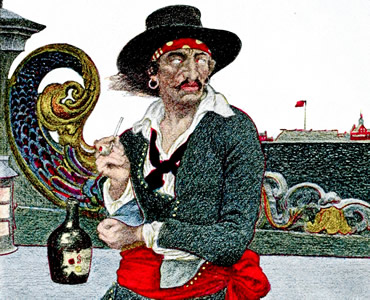
Artist: Howard Pyle
A Bizarre Portrait of Rather Dyspeptic Kidd Relaxing with an Inaccurate
Bottle On Deck (pre-1911)
Bottles of alcohol were also served on land in taverns. In his epic poem of life in the British Navy aboard HMS St. David, John Baltharpe mentions while in port at Alicante, Spain, the men were drinking wine and "The Bottle is not long a emptying: When that is out, we'l fill another, When that is gone, we must have t'other."11 His comment 'When that is out we'll fill another' makes it sound as if the bottles may have been used by the tavern to transport the liquid from a cask to the table.
Captain Jacob's selling of alcohol to the pirates in Madagascar from his ship in June of 1698 mentions that wine was sold "By the whole Barril att 3 pc of 8 a Gall[o]n, but most retailed at a pc of 8 the Bottle"12. Here again, the bottles may have been filled from the casks, although Olive Jones points out that by the mid/late eighteenth century, beer, ale and cider were shipped bottled between Britain, America and the West Indies.13 She also states that "distilled liquors, however, appear to have been bottled at, or close to, the retail level."14
1 Olive R. Jones, Cylindrical English Wine and Beer Bottles 1735-1850, 1986, p. 18; 2 Jones, p. 18-9; 3 Daniel Defoe (Captain Charles Johnson), A General History of the Pyrates, Manuel Schonhorn, ed., 1999, p. 628; 4 Defoe (Captain Charles Johnson), p. 631; 5 Defoe (Captain Charles Johnson), p. 639; 6 “109. Deposition of Thomas FitzGerald and Alexander Mackonochie. May 6, 1717.”, Privateering and Piracy in the Colonial Period Illustrative Documents, John Franklin Jameson, 1923, p. 253; 7 Edward Barlow, Barlow’s Journal of his Life at Sea in King’s Ships, East and West Indiamen & Other Merchantman From 1659 to 1703, p. 298; 8 Ed Fox, “47. John Fillmore’s narrative”, Pirates in Their Own Words, 2014, p. 233; 9 Barlow, p. 188; 10 Barlow, p. 334; 11 John Baltharpe, The straights voyage, or, St. Davids poem, 1671, p. 53; 12 Ed Fox, “67. Prices of Pirate Supplies: A List of the Prices that Capt. Jacobs sold Licquors and other Goods att, at St. Mary’s, 9 June, 1698…”, Pirates in Their Own Words, 2014, p. 362; 13,14 Jones, p. 19
Containers for Alcohol: Bottle Frequency
Bottles are mentioned fourteen times in the sailor's accounts under study1. They are 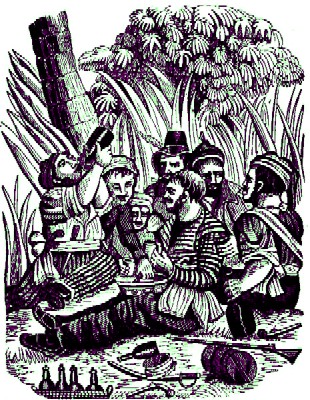
A Fairly Inaccurate Image of Pirates Drinking on Shore,
From
The Pirate's Own Book, By Charles Ellms (1837)
primarily mentioned as containing wine2, although there are also mentions of them being used as containers for ale and cider3, brandy4 and even rum5. (Despite the popular notion that pirates swigged rum straight from the bottle, it actually seems to have been shipped primarily in casks.)
The pirates appear to particularly enjoy bottled alcohol. This may be because the better fermented products such as those likely to be found in the officer's cabins were often bottled. Merchant captain Nathaniel Uring reported,
The [Log]Wood-Cutters are generally a rude drunken Crew, some of which have been Pirates [probably referring to buccaneers], and most of them Sailors; their chief Delight is in drinking; and when they broach a Quarter Cask or a Hogshead of Wine, they seldom stir from it while there is a Drop left: It is the same thing when they open a Hogshead [referring here to the quantity, not the cask] of Bottle Ale or Cyder, keeping at it sometimes a Week together, drinking till they fall asleep; and as soon as they awake, at it again, without stirred off the Place.6
Further proof of the popularity of bottles among the logwood cutters (and, by association, retired pirates) comes from a study done in the 1990s by archaeologist Daniel Finamore and a team of researchers who excavated an eighteenth century logwood cutter site on the Belize River called Barcadares.
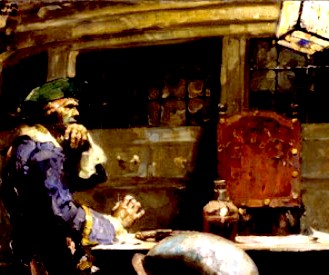
Artist: Mead Schaeffer
Another Fanciful Modern Pirate Illustration. (1920)
From an analysis of the dig written by Heather Hatch we know that they found containers or fragments of them for eighty-nine bottles, five jugs and a teapot. No cups or tankards were discovered. This means 93% of the discarded drinking containers at the logwood camp were bottles. Hatch compares the Bacadares logwood cutter site with excavations of two 'civilized' colonies on Nevis from around the same period. She points out that the bottle percentages found "at the Barcadares comprises nearly double the percentage of the total assemblage in comparison to the two Nevisian sites", where bottles comprised 5% and 55% of the total number of drinking containers discovered.7 Clearly the logwood cutters had an affinity for bottled beverages.
One thing pirates do not seem to have liked about bottles were the corks. This dislike may have been magnified because the the corks were either waxed or tied down as mentioned previously. Whatever the problem, there are several accounts of pirates not bothering to remove them.
Surgeon Adam Comrie, whose ship Elizabeth was captured by Bartholomew Roberts reported that when the pirates boarded, they "asked for Liquor, knocking off the heads of the Bottles like one who did not design to pay for them"8. Of Robert's crew, the Boston News-Letter reported,
the Pirates made themselves very merry aboard of Capt. Carry’s Ship with some Hampers of fine Wines that were either presents, or sent to some Gentlemen in Boston; it seems they would not wait to unty them and pull out the Corks with Skrews, but each man took his bottle and with his Cutlash cut off the Neck and put it to their Mouths, and drank it out.9
When captured by the fleet of captains Howell Davis, Thomas Cocklyn and Olivier Levasseur, William Snelgrave explained, "As to bottled Liquor of many sorts, they made such havock of it, that in a few days they had not one Bottle left: For they would not give themselves the trouble of drawing the Cork out, but nick'd the Bottles, as they called it, that is, struck their necks off with a Cutlace; by which means one in three was generally broke"10.
Although these accounts make it sound as if the pirates simply cut or broke the heads off the bottles (which could have resulted in a rather jagged drinking orifice), it is more likely they used their blades to score
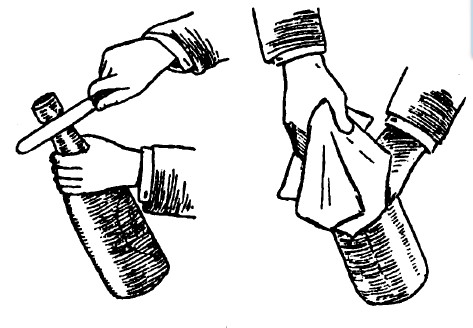
Knocking the Head off a Bottle, From
Picture Paragraphs, p. 152 (1907)
the glass so that it could be easily snapped off. This process is described in detail in the book Picture Paragraphs:
If you haven't a corkscrew, you can open a bottle by drawing a knife vigorously round, the neck of the bottle just behind the rim that incloses the cork, as if you were going to saw its head off. This will scratch the enamel. Then lay the knife-blade flat on the bottle, and with the back of the blade strike the bottle rim a few sharp blows lengthwise of the bottle as if you would knock its head off. Presently you will hear it break, which it will do in the line of the scratches. Now put a napkin over the head, and pull as if you were drawing the cork, and the head and all will come off quite clean.11
Whether they bothered to cover the top with cloth in the process isn't clear, but nicking the bottle probably refers to scoring the glass with the sharp side of the blade. While the period accounts all suggest this was done for expediency, laziness or perhaps as an act of wanton destruction, researcher John Franklin Jameson suggests it was because they were 'painfully destitute of corkscrews.' He explains that when the same crew captured a chaplain, they "kept nothing which belonged to the Church, except three Prayer-Books, and a Bottle-Screw, which, as I was inform'd by one of the Pyrates himself, they said they had Occasion for, for their own Use"12.
1 Ed Fox, “67. Prices of Pirate Supplies: A List of the Prices that Capt. Jacobs sold Licquors and other Goods att, at St. Mary’s, 9 June, 1698…”, Pirates in Their Own Words, 2014, p. 362, Daniel Defoe (Captain Charles Johnson), A General History of the Pyrates, Manuel Schonhorn, ed., 1999, p.261, 639, The Boston News-Letter, Monday August 15 to Monday August 22. 1720, Defoe (Captain Charles Johnson), p. 261, 628, 631, 639, Ed Fox, “47. John Fillmore’s narrative”, Pirates in Their Own Words, 2014, p. 233, Charles Grey, Pirates of the Eastern Seas, 1618-1723, 1971, p. 33, “109. Deposition of Thomas FitzGerald and Alexander Mackonochie. May 6, 1717.”, Privateering and Piracy in the Colonial Period Illustrative Documents, John Franklin Jameson, 1923, p. 253, Woodes Rogers, A Cruising Voyage Round the World, 1712, p. 279, Nathaniel Uring, A history of the voyages and travels of Capt. Nathaniel Uring, 1928, p. 241 & John Baltharpe, The straights voyage, or, St. Davids poem, 1671, p. 53; 2 Fox, p. 362, The Boston News-Letter, Monday August 15 to Monday August 22. 1720, Defoe (Captain Charles Johnson), p. 631, “109. Deposition of Thomas FitzGerald...", p. 253, Rogers, p. 279 & Baltharpe, p. 53; 3 Nathaniel Uring, A history of the voyages and travels of Capt. Nathaniel Uring, 1928, p. 241; 4 Fox, p. 233; 5 Defoe (Captain Charles Johnson), p. 639; 6 Uring, p. 241; 7 Heather E. Hatch, "Material Culter and Maratime Identity: Identifying Maritime Subcultures Through Artifacts", The Archaeology of Martime Landscapes, Ben Ford, ed., 2012, p. 227; 8 "Pyrates Lately taken by Captain OGLE", 1723, p. 44; 9 The Boston News-Letter, Monday August 15 to Monday August 22. 1720; 10 Captain William Snelgrave, A New Account of Some Parts of Guinea and the Slave Trade, 1734, p. 234; 11 Picture Paragraphs, From Pearson's Weekly, 1907, p. 152; 12 John Franklin Jameson, Privateering and Piracy in the Colonial Period - Illustrative Documents, 1923, p. 269

